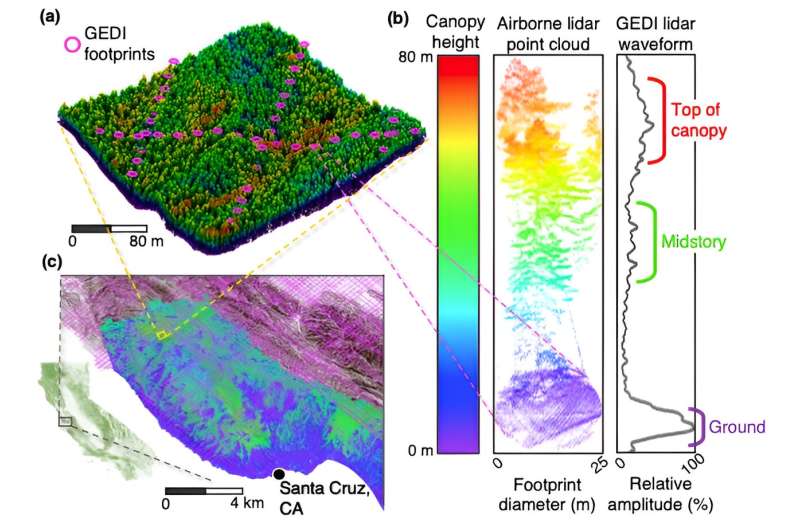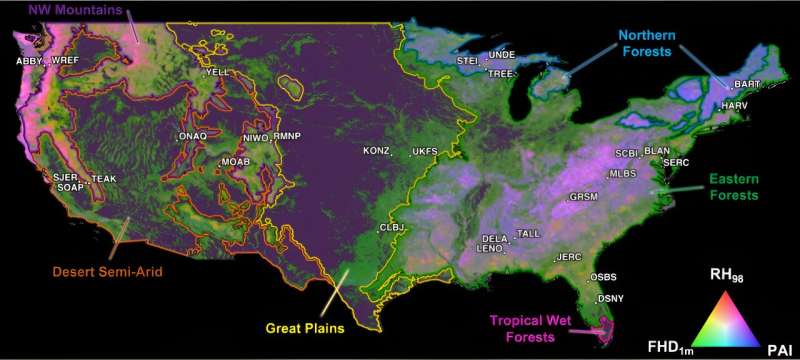
Measuring biodiversity across the US with space-borne lidar (Image Credit: Phys.org)

Diverse ecosystems support the web of life and in the process, provide food, water, medicine and materials for humanity. But the butterfly effect tells us all things are connected. So, when biodiversity loss threatens the foundation upon which we live, what does that mean for the future of Earth and humanity?
Currently, more than 1 million species are on the verge of extinction due primarily to habitat destruction, especially the conversion of forests to agriculture, and overexploitation like hunting and fishing. Owing to the gravity of the challenge, global consensus has emerged on the urgency to develop better ways to map and monitor biodiversity at large scales, like we do for climate change.
In a first-of-its-kind study, recently published in Environmental Research: Ecology, NAU research professor Chris Hakkenberg illustrates how state-of-the-art technologies can be used to mitigate the impact of global biodiversity loss: by monitoring biodiversity across the United States using NASA’s Global Ecosystem Dynamics Investigation (GEDI) space-borne lidar—a safe, invisible laser that can detect 3D forest structure from the International Space Station.
This study was inspired by coordinated international efforts, including the Convention on Biological Diversity’s plea to scientists to explore using satellite remote sensing to monitor trends in global biodiversity. The logic is simple: If the biodiversity of Earth’s forests can be accurately mapped, and biodiversity trends over time become apparent, researchers and policymakers can use these data to help develop mitigation efforts. The key, however, is making these maps as accurate as possible.
Previous research on the topic used satellite imagery (like that seen on Google Maps) to get a coarse view of where forests are and, by extension, to predict where species might be. However, this view is two-dimensional, only showing the top of forest canopies with little insight into what is happening below—the habitat for ground plants, mammals and birds. Hakkenberg’s research shows it is possible to go beyond this simple bird’s-eye view and use the entire 3D structure of forests to predict habitat for plants and animals.
“We are using NASA’s Global Ecosystem Dynamics Investigation (GEDI) space-borne lidar to estimate the entire 3D structure of forests which we can then use to predict the biodiversity contained within,” he said.
GEDI emits invisible laser pulses toward the Earth’s surface, and like radar, tracks the time difference between when the laser is emitted and when it returns to measure how far those sensed objects are. “This means we can go beyond just measuring tree heights but also get a clear picture of the entire vertical distribution of branches, leaves and needles from the ground to the top of the canopy.”

Because forest structure is related to variation in the size and form of different species of trees, Hakkenberg and colleagues were able to use these 3D waveform profiles of forest structure to model a relationship between tree structure and tree biodiversity measured with field data from the National Ecological Observation Network across the United States, excluding Alaska.
“While attention to biodiversity-structure relationships has been growing in the international research communities over the last decade, it has generally focused on tree species diversity because trees form the essential building blocks of forests and are large enough to be detected from space,” Hakkenberg said.
“But what was really interesting about our findings is that these biodiversity-structure relationships extend to plant biodiversity too. Even though we can’t directly detect individual ground plants from the space-borne platform, we can predict the diversity of those plants from the 3D characteristics of the trees that surround them.”
These same relationships can be used to predict habitat for birds and arboreal mammals that each require different forest structural types.
Over the coming years, increasing amounts of remote sensing data from airplanes and space-borne sensors will be paired with field observations, providing scientists with efficient ways to monitor biodiversity at global scales. Through these detailed maps, more can be learned about biodiversity loss and thus where to shift efforts to slow and eventually stop it.
Hakkenberg and his colleagues from the School of Informatics, Computing, and Cyber Systems, including research associate Pat Burns; research professors Patrick Jantz and Zaneta Kaszta; Regent’s professor Scott Goetz; and graduate students Colin Quinn and Melissa Rose, are excited about their findings. They hope this study moves the needle on continental-scale biodiversity research by employing state-of-the-art NASA technologies and brings increased attention to biodiversity loss.
“It is extremely urgent that we devise better ways to map and monitor biodiversity at large scales, like we do for climate change,” Hakkenberg said. “This study is a part of that greater effort, giving us a fighting chance to address these issues before it’s too late.”
More information:
C R Hakkenberg et al, Inferring alpha, beta, and gamma plant diversity across biomes with GEDI spaceborne lidar, Environmental Research: Ecology (2023). DOI: 10.1088/2752-664X/acffcd
Provided by
Northern Arizona University
Measuring biodiversity across the US with space-borne lidar (2023, November 28)
retrieved 29 November 2023
from https://phys.org/news/2023-11-biodiversity-space-borne-lidar.html
part may be reproduced without the written permission. The content is provided for information purposes only.





